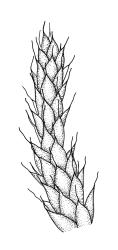Plants rather robust, forming flat yellowish-brown, red-brown, or red mats. Stems red-brown, wiry, in cross-section with very thick-walled outermost cells grading gradually into medullary cells and lacking a central strand. Stem and branch leaves differentiated by size. Stem leaves erect, imbricate, smooth even when dry, ovate, oblong, or oblong-panduriform, either abruptly tapered to a slender and often castaneous hair-point or acute, concave, recurved at lower margins, and mostly strongly inrolled above (accentuating the taper of the leaf tip), entire below, denticulate near apex, with a large and strongly differentiated alar group, ecostate. Branches variable in length on the same plant, straight or curved. Branch leaves smaller; upper laminal cells linear-rhomboidal or fusiform, firm-walled, obscure because of a very fine cuticular reticulum covering both surfaces, more or less porose (sometimes conspicuously so), becoming extremely thick-walled at the base of the acumen and more elongate towards the insertion; basal cells lacking cuticular reticulations and strongly orange-brown in several rows; marginal cells narrowly linear, smooth, forming a border extending to mid leaf or beyond, rarely not differentiated (in non-N.Z. taxa); alar cells thick-walled and brightly pigmented (usually red), forming a large, strongly differentiated, and auriculate group. Asexual propagulae lacking. Paraphyllia and pseudoparaphyllia absent.
Dioicous. Perichaetia scattered on stems. Perigonia inconspicuous, on stems. Setae smooth, red-brown; capsules erect, gymnostomous, broadly obovoid with a poorly defined neck, furrowed when dry; mouth transverse and wide; exothecial cells more or less isodiametric or rectangular, firm-walled; stomata restricted to neck, deeply immersed; annulus lacking; operculum obliquely long-rostrate. Peristome lacking. Calyptra cucullate. Spores ± tetrahedral.
Frahm (1996) considered the genus to include six species worldwide, with four species restricted to South and/or Central America. The characters by which Frahm (1996) differentiated taxa are primarily the presence/absence of an apical hair-point, the strength of the leaf border, and leaf shape. Magill & van Rooy (1998, p. 543) did not accept R. rehmannianus, which was accepted by Frahm, in their treatment of the genus for southern Africa.
Rhacocarpus purpurascens is the most widespread and best-known species in both the genus and family.
| Category | Number |
|---|---|
| Indigenous (Non-endemic) | 1 |
| Total | 1 |
Rhacocarpus: excluded species
Rhacocarpus strictipilus (Müll.Hal.) Par. was described from the Auckland Is as a Harrisonia by Müller (1897) using material collected by J.D. Hooker. Frahm (1996) was unable to locate type material, but indicated that it was probably a synonym of R. purpurascens. Little purpose would be served to question his conclusion.




